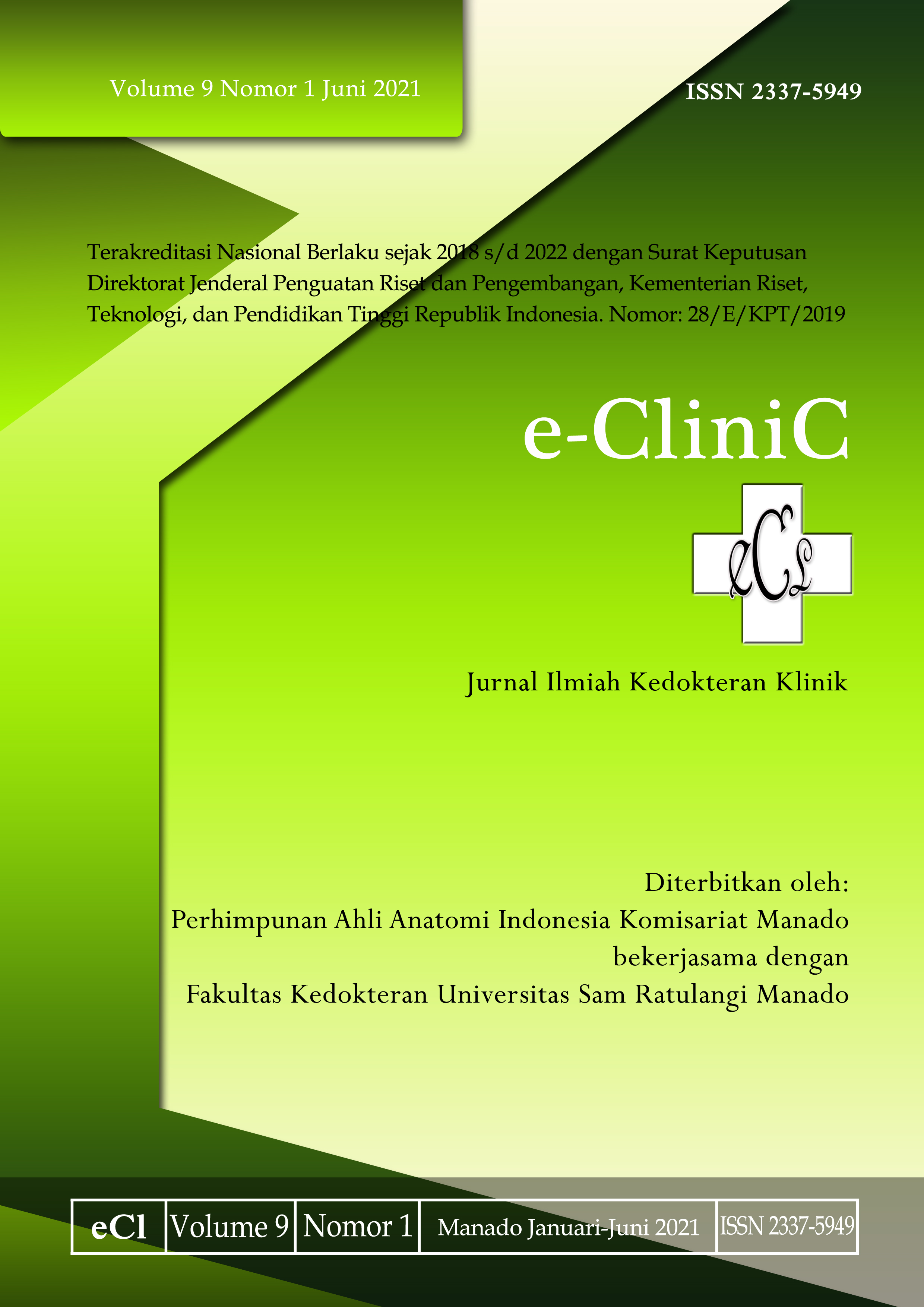Gambaran Pasien Stroke Iskemik Akut dengan COVID-19 yang Masuk Ruang Perawatan Intensif
DOI:
https://doi.org/10.35790/ecl.v9i1.32302Abstract
Abstract: Acute ischemic stroke (AIS) has been reported in patients with coronavirus disease 2019 (COVID-19). The cause of AIS in COVID-19 patients has not been fully understood, but COVID-19 is known to cause hypercoagulation characterized by increased d-dimer levels, and cytokine storms. Â Some AIS patients with COVID-19 require intensive care. This study was aimed to determine the description of AIS patients with COVID-19 admitted to the intensive care unit. This was a literature review study using three databases, as follows: Pubmed, ClinicalKey, and Science Direct. The keywords used were acute ischemic stroke AND COVID-19 AND intensive care unit. The results showed that after being selected based on inclusion and exclusion criteria, 10 literatures were obtained. There were 20 subjects and most were female (55%) and age group of 60-69 years old (35%). The most common cardiovascular risk factor was hypertension (80%, n=10). There were some increases in the levels of LDH, CRP, d-dimer, ferritinin, and fibrinogen. On radiological examination performed, there were cases with bilateral pulmonary infiltrate (33%) and ground-glass opacities (67%) (n = 6). In conclusion, the characteristics of AIS patients with COVID-19 admitted to the intensive care room were mostly female, age group 60-69 years, had cardiovascular risk factors for hypertension, had elevated levels of LDH, CRP, d-dimer, ferritinin, and fibrinogen, and had ground-glass opacity on radiological imaging.
Keywords: acute ischemic stroke, COVID-19, intensive care unit
Â
Abstrak: Stroke iskemik akut telah dilaporkan pada pasien dengan coronavirus disease 2019 (COVID-19). Penyebab stroke iskemik akut pada COVID-19 belum diketahui secara menyeluruh, tetapi COVID-19 dapat menyebabkan kejadian hiperkoagulasi ditandai dengan peningkatan kadar d-dimer serta menyebabkan badai sitokin. Beberapa pasien stroke iskemik akut dengan COVID-19 membutuhkan perawatan di ruang perawatan intensif. Penelitian ini bertujuan untuk mengetahui gambaran pasien stroke iskemik akut dengan COVID-19 yang masuk di ruang perawatan intensif. Jenis penelitian ialah literature review dengan pencarian data menggunakan tiga database yaitu Pubmed, ClinicalKey dan Science Direct dengan kata kunci acute ischemic stroke AND COVID-19 AND intensive care unit. Hasil penelitian mendapatkan 10 literatur dengan jumlah subyek penelitian sebanyak 20 orang, jenis kelamin terbanyak ialah perempuan (55%) dengan kelompok usia terbanyak ialah 60-69 tahun (35%). Faktor risiko kardiovaskular yang paling banyak dimiliki subyek penelitian ialah hipertensi (80%, n=10). Terdapat peningkatan kadar LDH, CRP, d-dimer, ferritinin, dan fibrinogen. Pada pemeriksaan radiologi ditemukan bilateral pulmonary infiltrate (33%) dan ground-glass opacitiy (67%) (n=6). Simpulan penelitian ini ialah karakteristik pasien stroke iskemik akut dengan COVID-19 yang masuk ruang perawatan intensif paling banyak ialah perempuan, usia 60-69 tahun, memiliki faktor risiko kardiovaskular hipertensi, mengalami peningkatan kadar LDH, CRP, d-dimer, ferritinin, fibrinogen, dan ditemukan ground-glass opacitiy pada gambaran radiologi.
Kata kunci: Stroke iskemik akut, COVID-19, ruang perawatan intensif
Downloads
How to Cite
Issue
Section
License
COPYRIGHT
Authors who publish with this journal agree to the following terms:
Authors hold their copyright and grant this journal the privilege of first publication, with the work simultaneously licensed under a Creative Commons Attribution License that permits others to impart the work with an acknowledgment of the work's origin and initial publication by this journal.
Authors can enter into separate or additional contractual arrangements for the non-exclusive distribution of the journal's published version of the work (for example, post it to an institutional repository or publish it in a book), with an acknowledgment of its underlying publication in this journal.
Authors are permitted and encouraged to post their work online (for example, in institutional repositories or on their website) as it can lead to productive exchanges, as well as earlier and greater citation of the published work (See The Effect of Open Access).







